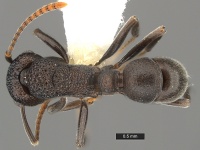Rhytidoponera depilis
This rainforest species is found along the coast foraging on low vegetation. The nests are distinctive in the form of a clay turret constructed around the base of a sapling.
| Rhytidoponera depilis | |
|---|---|

| |
| Scientific classification | |
| Kingdom: | Animalia |
| Phylum: | Arthropoda |
| Class: | Insecta |
| Order: | Hymenoptera |
| Family: | Formicidae |
| Subfamily: | Ectatomminae |
| Tribe: | Ectatommini |
| Genus: | Rhytidoponera |
| Species: | R. depilis |
| Binomial name | |
| Rhytidoponera depilis Ward, 1984 | |
Identification
This is a large, black pulchella-group species which can be immediately recognized by the lack of erect hairs on most parts of the body and by the densely pubescent gastric tergites.
Distribution
Latitudinal Distribution Pattern
Latitudinal Range: -22.16666603° to -22.23333333°.
| North Temperate |
North Subtropical |
Tropical | South Subtropical |
South Temperate |
- Source: AntMaps
Distribution based on Regional Taxon Lists
Australasian Region: New Caledonia (type locality).
Distribution based on AntMaps
Distribution based on AntWeb specimens
Check data from AntWeb
Countries Occupied
| Number of countries occupied by this species based on AntWiki Regional Taxon Lists. In general, fewer countries occupied indicates a narrower range, while more countries indicates a more widespread species. |

|
Estimated Abundance
| Relative abundance based on number of AntMaps records per species (this species within the purple bar). Fewer records (to the left) indicates a less abundant/encountered species while more records (to the right) indicates more abundant/encountered species. |

|
Biology
R. depilis is known only from coastal rainforest (10 m elevation). Workers were observed foraging on low vegetation. Two colonies were collected: both were located in soil next to a small sapling, and had a distinctive nest entrance in the form of a clay turret constructed around the base of the sapling.
Castes
Nomenclature
The following information is derived from Barry Bolton's Online Catalogue of the Ants of the World.
- depilis. Rhytidoponera depilis Ward, 1984: 157, figs. 39, 40, 45, 46 (w.) NEW CALEDONIA.
- Type-material: holotype worker, paratype workers (number not stated).
- Type-locality: holotype New Caledonia: Fausse Yaté Rivière, 10 m., 22°10’S, 166°55’E, 26.iv.1980, acc. no. 4106, on low vegetation, rainforest (P.S. Ward); paratypes with same data but acc. nos 4104, 4106 (P.S. Ward), workers 6 km. SE Touaourou, 10 m., 23°14’S, 167°00’E, 27.iv.1980, acc. nos 4130-1, 4131 (P.S. Ward), 2 workers Touaourou, 20.x.1958 (B. Malkin).
- Type-depositories: ANIC (holotype); ANIC, BMNH, BPBM, MCZC, MNHN, PSWC (paratypes).
- Status as species: Taylor, 1987a: 71; Bolton, 1995b: 379.
- Distribution: New Caledonia.
Type Material
- Holotype, worker, Fausse Yate Riv., New Caledonia, Ward,P., ANIC32-000001, Australian National Insect Collection.
- Paratype, 1 worker, Fausse Yate Riv., New Caledonia, Ward,P., ANIC32-000003, Australian National Insect Collection.
- Paratype, 1 worker, Fausse Yate Riv., New Caledonia, The Natural History Museum.
Description
Holotype worker. New Caledonia: Fausse Yate Riviere 10 m, 26. iv. 1980, foraging on low vegetation, rainforest (P.S. Ward acc. No. 4106) (ANIC Type No. 7581).
Paratype workers: (1)A series of 2 accessions from Fausse Yate Riviere (P.S. Ward acc. Nos 4104, 4106) (ANIC, PSW). (2)A series of 2 accessions from 6 km SE Touaourou, 10m, 27. iv. 1980, workers foraging on low vegetation and nesting in soil at base of sapling, rainforest (P.S. Ward acc. Nos 4130-1, 4131) (BMNH, MCZ, MNHN, PSW). (3) 2 workers, Touaourou, 20.x.1958 (B. Malkin) (BPBM).
Non-paratypic material: 1 worker, Oubatche (Sarasin and Roux)(MHN). I suspect that this worker, which Forel presumably received from Emery, has been mislabelled. Oubatche is north-west of Hienghene, at the opposite end of the island to the type locality. It is possible that this specimen is the 'puchella' worker which Emery (1914, p. 396) referred to, and briefly described, from Yate.
Measurements <br.
Holotype worker. HW 1.24, WL 1.91, CI 0.91, MI 0.36, SI 1.05, SL12 0.19, SSC 0, FSC 0.
Paratype workers. HW 1.18-1.24, WL 1.78-1.85, CI 0.89-0.92, MI 0.35-0.40, SI 1.01-1.05, SL13 0.17-0.20, SSC 0, FSC 0 (n=9).
Diagnosis of Worker
Similar to arbores (Q.V.) in relative body dimensions, sculpture, and colour. Eyes a little larger (OI 0.27-).30). Occipital lobes broadly rounded and not protruding in lateral view. Pronotum averaging a little more slender than in arborea (PI 0.74-0.78). Petiolar node relatively narrow in dorsal view (PN12 0.42-0.450. Subpetiolar proess with a rather broad tooth (SPI 0.21-0.31). Rugose sculpture on head becoming longitudinally rugostriate on vertex, near the posterior margin. Inter-rugal punctures on pronotum becoming isolated on the sides, surrounded by irregular striate sculpture. Sculpture on petiolar node and abdominal tergite III finder than in arborea (rugulose on node; finely rugostriate to striate on abdominal tergite III). Erect pilosity sparse or absent on most of the upper body surface, lacking entirely on the legs and scapes; gastric tergites covered by a dense mat of appressed pubescence, which is multibranched on abdominal tergit IV.
References
Ward, P. S. 1984. A revision of the ant genus Rhytidoponera (Hymenoptera: Formicidae) in New Caledonia. Aust. J. Zool. 32: 131-175(page 157, figs. 39, 40, 45, 46 worker described)
References based on Global Ant Biodiversity Informatics
- CSIRO Collection
- Jennings J. T., L. Krogmann, and C. Burwell. 2013. Review of the hymenopteran fauna of New Caledonia with a checklist of species. Zootaxa 3736(1): 1-53.
- Taylor R. W. 1987. A checklist of the ants of Australia, New Caledonia and New Zealand (Hymenoptera: Formicidae). CSIRO (Commonwealth Scientific and Industrial Research Organization) Division of Entomology Report 41: 1-92.
- Ward P. S. 1984. A revision of the ant genus Rhytidoponera (Hymenoptera: Formicidae) in New Caledonia. Aust. J. Zool. 32: 131-175.
- Ward P. S. 1985. Taxonomic congruence and disparity in an insular ant fauna: Rhytidoponera in New Caledonia. Systematic Zoology 34: 140-151.

